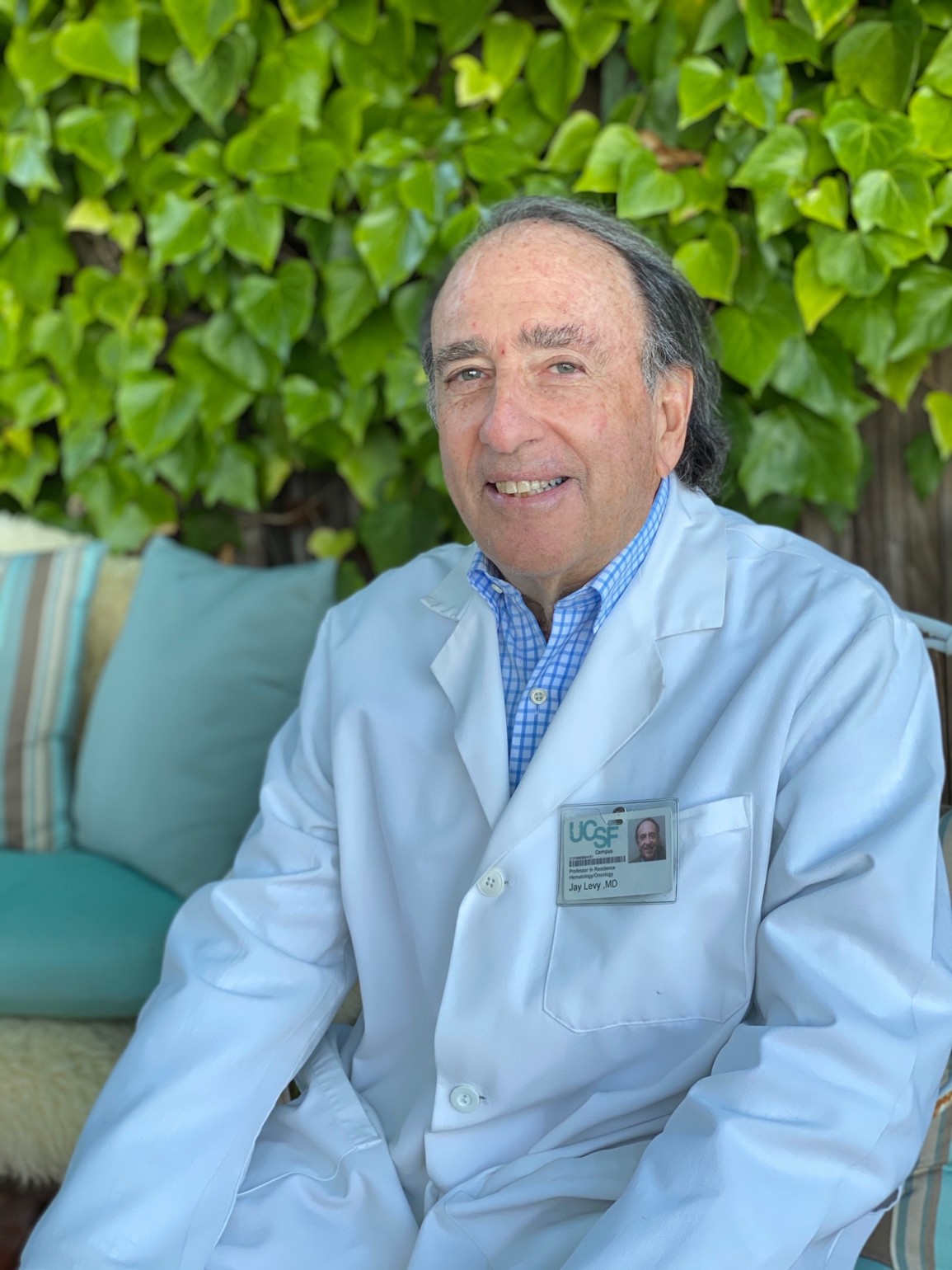
We can’t turn on a screen without the latest update on COVID-19 and communities devastated by the pandemic. The news and information seems to change daily, so we caught up with a doctor, very familiar with hard challenges, Dr. Jay A. Levy, to turn to and answer some basic questions. Dr. Levy, co-discovered HIV in 1983 and is currently a Professor of Medicine and Director of the Laboratory for Tumor and AIDS Virus Research at the University of California, San Francisco (UCSF). In addition to his AIDS research, he has published 14 books and over 600 articles in virology, immunology and infectious diseases. Hence, we were interested in his take on the virus that has kidnapped our old normal.
What is this disease called COVID-19? What is its cause and where did it come from?
COVID-19 is primarily a respiratory disease characterized by difficulty in breathing and symptoms of the common cold. Generally, sneezing is not involved but dry coughs and fever (not generally high) as well as muscle aches and pains occur. The cause is a coronavirus related (like a first cousin) to the one that caused SARS (Severe Acute Respiratory Syndrome) in 2003. Importantly, the genetic sequence of COVID-19 is very similar to that of SARS. Therefore, we know that COVID-19 is a naturally occurring virus and was not made in a laboratory. Moreover, many studies have indicated that it did not come from a laboratory in China but most likely is present in bats living in southern China.
Early reports suggested that COVID-19 was transmitted to humans in an open market in Wuhan, China. Most of the early cases were people who had visited that market. This virus perhaps infected another animal (in the case of SARS it was a wild cat, a civet) and mutated sufficiently to readily infect humans who were in the market. COVID-19 appears to be transmitted more easily than SARS and can give rise to infection without symptoms (asymptomatic people) in about 40% of cases. Then, it is estimated that another 40% of infected individuals will have mild to moderate symptoms that do not need hospitalization. The other 20% with COVID-19 infection could require hospitalization of which about 5% may need to be placed on respirators or ventilators to help with breathing.
Whereas SARS virus infected 8,000 people worldwide with 800 deaths, COVID- 19 has already infected over 7 million people with 500,000 deaths. In the United States, we have had over 2 million infections with 110,000 deaths. In California we have had at least 150,000 infections with about 5,000 deaths. Thus, the fatality rate for COVID-19 appears to be less than that with SARS although the transmission of COVID-19 is much greater. Importantly, SARS was controlled by the very effective and early response to the infection and there have been no new cases reported worldwide.
Why do some people get sick while others are infected but do not have symptoms?
With COVID-19 infection, some individuals have an immune system that can immediately control the virus so that no symptoms occur. This control from the very earliest activity of the immune system is called the innate immune response. That immune activity in the nose, mouth and other body surfaces can act within minutes to days and prevent the establishment of the infection. If the innate immune system does not successfully ward off this virus, the adaptive or acquired immune system comes in for the defense. That immunity involves the production of proteins called antibodies that circulate in the blood and can attach to the virus and kill it. This adaptive immune system also has cells that can attack virus-infected cells to destroy them. Importantly, these two defense mechanisms of the acquired immune system are the main cause of most of the symptoms that appear with the infection. A very strong response can give destruction of the lung and diseases of the heart and other tissues in which the virus can be found. This hyper-reactive immune system becomes a major culprit in causing the disorders seen with COVID-19 infection. The response includes the production of cellular products or proteins, called cytokines, that attempt to destroy the virus. Unfortunately these products can be very toxic to the individual and cause major diseases in lung, heart and other tissues. The release of these proteins in waves give severe symptoms and have been referred to as “cytokine storms.” They need to be controlled to decrease the toxicity to the infected person. If not, the affected person may require the use of ventilators or respirators to maintain their breathing. Part of this enhanced responsive immune system is the formation of blood clots that can block blood flow to the kidney, heart, lungs and brain.
One of the important observations with COVID-19 infection is that young people often do not show symptoms and recover quickly. In this case, young people may have a natural innate immune response that is more effective than that in adults. Also, we know in the immune system there are cells called T regulatory cells that are responsible for bringing a balance to immune responses. Without these T regulatory cells in adequate amounts, individuals can develop signs of autoimmunity such as lupus and rheumatoid arthritis.
Once one recovers from this disease, can re-infection take place?
It is not yet known definitively if an individual, once infected, has an immune response, such as production of antiviral antibodies, that protects them from getting COVID-19 again. Studies in monkeys infected in the laboratory with this virus have indicated that there is protective immunity induced by the initial infection. Importantly, when one reports finding evidence of the virus in individuals after they have been “cured,” that evidence is using tests that detect the genetic material of the virus that in most cases will indicate a dead virus. Essentially the immune system has handled that infection. We know in virology that even after you have been infected or vaccinated against measles, mumps and chickenpox, that virus can still infect the person and replicate for a few cycles without producing any symptoms. Then the immune system in that person will recognize the virus and respond effectively to eliminate it. That response could be what can occur as well with this coronavirus.
When is it possible to open up communities to normal activity during this virus pandemic?
We know that the human population is very susceptible to COVID-19 since we have not seen this virus before. Therefore, there is no immunity against it. Since many people can be infected and not show severe symptoms, those individuals can form what we call “herd immunity.” This means that if the virus tries to infect those individuals the infection will not take place and the spread of the virus is stopped. This “herd” of people prevents the virus from infecting others. Some viruses such as measles spread so quickly that that herd immunity require as high as 90% of the community to have already been exposed to the virus or to its vaccine. For COVID-19, the herd immunity needs to be about 60% based on how many people can be infected by an infected person.
The role of public health is to prevent infection… In addition, public health officials recognize that the regular activities of a community need to resume as soon as possible. Therefore, the approach is to open a community to somewhat normal activity when hospitals are sufficiently equipped with equipment to reduce fatalities. Meanwhile, to lessen the spread of the virus, which would increase the number of people who could become severely ill, masks should be worn, social distancing should be followed and all citizens of the community should be washing their hands often. Most importantly, communities must have the facilities in place to handle those who become severely ill. Success is really measured by the reduction in deaths.
More from Marin:
- The Bravest Warriors Can Be Small
- 5 Things You Can Do Now
- Keep the Olympic Spirit Going in Marin: Join the Marin Magazine Decathlon
 Paige Peterson is a photojournalist who splits her time between Belvedere, California and New York City. As an illustrator, she has collaborated on “A Christmas Carol,” adapted by Jesse Kornbluth, and “Blackie: The Horse Who Stood Still,” which she co-authored with Christopher Cerf. Her next book “Growing Up Belvedere” will be published in October 2020. As a painter, she is represented by Gerald Peters Gallery in New York City and has been honored by The Guild Hall Academy of the Arts in East Hampton. She is a consultant to the Huntsman Cancer Foundation, the Author and Artist in Residence at Literacy Partners, serves on the board of the National Council on U.S.-Arab Relations and has reported extensively on the Middle East. Peterson is also an International Conservation Communication Specialist at Safari West and the Cheetah Conservation Fund Ambassador to the Middle East.
Paige Peterson is a photojournalist who splits her time between Belvedere, California and New York City. As an illustrator, she has collaborated on “A Christmas Carol,” adapted by Jesse Kornbluth, and “Blackie: The Horse Who Stood Still,” which she co-authored with Christopher Cerf. Her next book “Growing Up Belvedere” will be published in October 2020. As a painter, she is represented by Gerald Peters Gallery in New York City and has been honored by The Guild Hall Academy of the Arts in East Hampton. She is a consultant to the Huntsman Cancer Foundation, the Author and Artist in Residence at Literacy Partners, serves on the board of the National Council on U.S.-Arab Relations and has reported extensively on the Middle East. Peterson is also an International Conservation Communication Specialist at Safari West and the Cheetah Conservation Fund Ambassador to the Middle East.

